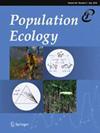Revisiting scale invariance and scaling in ecology: River fractals as an example
IF 1.1
4区 环境科学与生态学
Q4 ECOLOGY
引用次数: 0
Abstract
Scale invariance, which refers to the preservation of geometric properties regardless of observation scale, is a prevalent phenomenon in ecological systems. This concept is closely associated with fractals, and river networks serve as prime examples of fractal systems. Quantifying river network complexity is crucial for unveiling the role of river fractals in riverine ecological dynamics, and researchers have used a metric of “branching probability” to do so. Previous studies showed that this metric reflects the fractal nature of river networks. However, a recent article by Carraro and Altermatt (2022) contradicted this classical observation and concluded that branching probability is “scale dependent.” I dispute this claim and argue that their major conclusion is derived merely from their misconception of scale invariance. Their analysis in the original article (fig. 3a) provided evidence that branching probability is scale‐invariant (i.e., branching probability exhibits a power‐law scaling), although the authors erroneously interpreted this result as a sign of scale dependence. In this article, I re‐introduce the definition of scale invariance and show that branching probability meets this definition. This provided an opportunity to address the divergent use of “scale invariance” and “scaling” between fractal theory and ecology.重新审视生态学中的尺度不变性和尺度:以河流分形为例
尺度不变性是指无论观测尺度如何都能保持几何特性,是生态系统中普遍存在的现象。这个概念与分形密切相关,河流网络是分形系统的主要例子。量化河网复杂性对于揭示河流分形在河流生态动力学中的作用至关重要,研究人员已经使用了“分支概率”的度量来做到这一点。先前的研究表明,该度量反映了河网的分形性质。然而,Carraro和Altermatt(2022)最近的一篇文章反驳了这一经典观察结果,并得出结论,分支概率是“尺度相关的”。我对这一说法提出异议,并认为他们的主要结论只是源于他们对尺度不变性的误解。他们在原始文章中的分析(图3a)提供了证据,证明分支概率是标度不变的(即,分支概率表现出幂律标度),尽管作者错误地将这一结果解释为标度依赖的迹象。在这篇文章中,我重新介绍了尺度不变性的定义,并证明了分支概率满足这个定义。这为解决分形理论和生态学之间“尺度不变性”和“尺度”的不同使用提供了机会。
本文章由计算机程序翻译,如有差异,请以英文原文为准。
求助全文
约1分钟内获得全文
求助全文
来源期刊

Population Ecology
环境科学-生态学
CiteScore
3.90
自引率
11.80%
发文量
41
审稿时长
18-36 weeks
期刊介绍:
Population Ecology, formerly known as Researches on Population Ecology launched in Dec 1952, is the official journal of the Society of Population Ecology. Population Ecology publishes original research articles and reviews (including invited reviews) on various aspects of population ecology, from the individual to the community level. Among the specific fields included are population dynamics and distribution, evolutionary ecology, ecological genetics, theoretical models, conservation biology, agroecosystem studies, and bioresource management. Manuscripts should contain new results of empirical and/or theoretical investigations concerning facts, patterns, processes, mechanisms or concepts of population ecology; those purely descriptive in nature are not suitable for this journal. All manuscripts are reviewed anonymously by two or more referees, and the final editorial decision is made by the Chief Editor or an Associate Editor based on the referees'' evaluations.
 求助内容:
求助内容: 应助结果提醒方式:
应助结果提醒方式:


